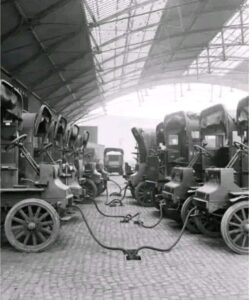Electric Vehicles: history repeating itself — It seems like that the more some things change, the more they stay the same.
Crude electric carriages were first invented in the late 1820’s and 1830’s. Practical, commercially available electric vehicles appeared during the 1890’s. An electric vehicle held the vehicular land speed record until right around 1900.
For a variety of technical and social reasons, electric vehicles prevailed to become a highly preferred mode of transportation by 1902.
Drivers considered passenger and commercial electric vehicles to be neater and they were especially cleaner than gasoline and steam powered vehicles since they produced no steam or odor.
Electric vehicle technology was not only embraced by early drivers, it also improved drastically. Thomas Edison perfected his nickel-iron storage battery in 1909, and the storage capacity of batteries increased 35% from 1910 to 1925 with a corresponding increase in range of 230%. Rechargeable lead–acid batteries could provide modest output over long periods or large output in short bursts.
With all of the excitement around electric back in the day, it looked as if the sky was the limit. Despite these high hopes, the use of electric vehicles peaked in 1901 and 1902, when about 62% of motorized vehicles in the country were electric-powered.

Electric began declining around 1902 and then sharply dropped off. So much so that by 1920 they constituted less than 2% of the overall market. Even the commercial sector slowly abandoned them: in 1913, 10% all commercial vehicles were electric powered, but by 1925 the number had dropped to less than 3%.
Here in 2024 we’re facing many of the same technological problems that we faced clear back in 1902.
Back in 1902, electric vehicles required special time-consuming recharging stations, as most could travel only 25 miles or so between charges. (roughly 250 average miles today even with vastly improved roads)
Back in 1902 electric vehicles were more expensive than gasoline vehicles, had slower top speeds, were difficult to charge, and were mostly confined to urban areas.
Drivers found it difficult and expensive to have electric vehicles recharged at gas stations and hotels, which differed in their rates for charging, while gas stations listed prices clearly.
Early gas vehicles cost $1,000 to $2,000 whereas electric vehicles cost $1,250 to $3,500. The high initial price of electric vehicles convinced manufacturers to focus only on the luxury market (Tesla comes to mind here).
In the early 1920’s, the battery market for electric vehicles became fragmented and many of these companies went bankrupt due to mismanagement. Even with the government subsidies of today to the tune of billions of dollars for these so-called green companies, we still have corruption and green company failures at alarming rates across the country.
In the 1920’s, electric vehicles were pretty much suited to and were practical for only short urban trips that could be completed near charging stations and cities just like they are today.
Not too unlike today, the electric vehicles of the 1920’s performed poorly in hilly areas or on rough roads and were not well suited for mountains and heavy freight (todays horse trailors or RV’s).
The outbreak of World War I in 1914 cemented support in favor of gasoline vehicles. The federal government did not see electric vehicles as being well suited for military applications
Even today, military standards are set for speed, range, and improved performance that are much higher than what even the best electric vehicles can provide.
Electric vehicles had started out with high hopes in the 1890’s and by the 1920’s had proven the extent of their technological advancement. Here in 2024 we are seeing all of the same exact shortcomings and limitations to the electric vehicle market/industry that we saw clear back in 1924.
And just like back in 1924, the electric vehicle proponents of 2024 still believe in their technological optimism and are placing faith in human ingenuity to overcome all of the lingering technical problems that come with the electric vehicle.
Henry Jackson Howard wrote in a 1900 issue of Metropolitan Magazine that:
“… from this initial club run we must infer that up to the present electricity is the most popular motive power… With the city automobilist, electricity will continue in favor”.
I think that Henry Jackson Howard was right, in that the electric vehicle is best suited for the urban areas and cities. After all, with all of the push for electric vehicles originating in and coming from some of our largest cities, which is where all of the pollution is incidentally, the electric vehicle may be best mandated for use in those areas.
The last time I visited Los Angeles there was a sign disallowing trucks to drive on the Golden State Freeway. The Golden State Freeway passes directly through Los Angeles and it was mandated that only cars are allowed to drive that section of the interstate. I can see this as a great starting point for the implementation of mandatory electric vehicle use. Big city environ’s may one day wake up to see a sign that specifically disallows gas powered vehicles within the Los Angeles city limits for instance. With the way the world is these days, that idea isn’t as far fetched as it might seem.
The fact of the matter here is that electric vehicles are fairly limited — you can only do so much with electricity. Electricity isn’t something you can put into a can and carry home for a fixed or otherwise set price. Buying electricity isn’t at all like buying a head of lettuce.
Also, if it weren’t for the government wasting our tax dollars pushing a less than stellar technology, we wouldn’t even be having this conversation about electric vehicles because history told us over 100 years ago that this is it — electric has a place, but that place is small in the larger scheme of things.
There are reasons why the sales of electric vehicles have fallen off a cliff over this passed year. One of the reasons being that people are having to relearn the lessons that were taught 100 years ago.
Even Ford Motor Company, much to their disappointment, seeing billions of dollars invested in electric disappearing, never to return, (because some pie-in-the-sky environ decided to nap through high school history class … probably), learned that you can’t just believe a government that forces concepts that were already proven limited by the free market.
Ford Motor Company does have the right idea though. Instead of just tossing electric out the window, Ford realized that there’s a place for everything and continues to produce electric vehicles, albeit at a much more limited and realistic scale (Ford may have decided to focus only on the luxury market).
Electric vehicles are limited and need to be promoted and brought to the public in a realistic way.
There’s money in electric … there always has been. But getting money out of electric at the national level is pretty much only promoted by the folks that think everything that happened during the movie “The Little Mermaid” was real … or by folks that watched the movie “2012” and then turn around racking their brain trying to remember if that ever happened.
The electric vehicle in 2024 is being embraced for many of the same reasons that it was embraced for all of those many years ago. It doesn’t stink, it’s quiet, and it’s easy to operate.
You can’t really claim that the electric vehicle of 2024 is going to help save the environment when you stop to consider all of the environmental damage that’s being done just to get all of the materials together in order to build it. Even in spite of the fact that the electric vehicles of the 1920’s contained rechargeable lead–acid batteries, we can’t help but notice how the mining of Lithium might be adversely affecting our environment.
For the amount of ecological damage that has been and is being done with regard to electric vehicles, one sort of wonders if it all might be worth it at the end of the day when you stop and consider the over all limitations of the electric vehicle itself.
You can’t save the planet by destroying it. One day we may end up waking to another Berkeley Pit or worse, all for the sake of trying to (or being forced to) make a limited technology work.
notes:
EVs have 79% more reliability problems than gas cars, says Consumer Reports
https://foe.org/wp-content/uploads/2022/07/2022.07.25_Letter-to-Tesla-re-nickel-mining_WALHI.pdf
Lithium iron phosphate or lithium ferro-phosphate (LFP) is an inorganic compound with the formula LiFePO. It is a gray, red-grey, brown or black solid that is insoluble in water. The material has attracted attention as a component of lithium iron phosphate batteries, a type of Li-ion battery. This battery chemistry is targeted for use in power tools, electric vehicles, solar energy installations and more recently large grid-scale energy storage. – Wikipedia
In Argentina, indigenous communities report that lithium operations on their lands threaten their survival and the exercise of their rights. In Zimbabwe, where lithium exploitation is currently low (1%), the illicit financial flow has already been identified in the lithium mining sector. A recent study on the life-cycle water-scarcity footprint showed that water use associated with lithium-brine mining in Chile and China, mainly through evaporative loss, can create a high risk of natural freshwater scarcity for humans and nature.






